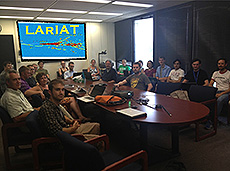Tracking particles with LArIAT
 |
Members of the LArIAT team gather for a weekly meeting. The graphic shows tracks from an electron and from a photon seen in the LArTPC detector. Photo: Flavio Cavanna |
A neutrino is a tricky thing: It rarely interacts with other particles, and it doesn't leave a track as it enters a detector. But a relatively new technology, called a liquid-argon time projection chamber, is helping scientists to understand them. MicroBooNE, the second phase of the Booster Neutrino Experiment, is one example of a LArTPC, and in order to help it do its job, scientists are first building a test detector called LArIAT—essentially a mini MicroBooNE.
LArIAT—Liquid-Argon TPC In A Test beam—is a small version of MicroBooNE, with a capacity for about three-quarters of a ton of liquid argon instead of MicroBooNE's 170 tons. Its aim is to study particle tracks to better understand how different types of particles—in particular electrons and photons—interact in liquid argon, and how these interactions appear in the collected data.
"Understanding what a proton track looks like in comparison to a pion track or a kaon track is one of the goals of LArIAT," said Jennifer Raaf, a spokesperson for the experiment.
LArIAT consists of a time projection chamber immersed in a cylinder of liquid argon. The TPC, a type of detector, has planes of ultra-sensitive wires that record when ionization electrons in the sea of argon touch them, allowing physicists to reconstruct the path of a particle through the argon.
The detector is bombarded with charged particles, such as pions, protons and electrons, from one of the test beams at the Fermilab Test Beam Facility. Future neutrino experiments such as MicroBooNE and LBNE will receive beams of neutrinos, which don't create any tracks as they enter the detector. Scientists on those experiments will have to look at the output from the collisions in order to deduce which kind of neutrino interacted, like crime scene sleuthing at the subatomic level.
"With a test beam, you can tag what types of particles are going in and then you can characterize how the detector responds to different types of particles," Raaf said. "And that's useful for every future and existing liquid-argon TPC. We're providing a kind of calibration for future experiments."
LArIAT started in earnest in February 2012 with a team of about 10 members. Now the collaboration has swelled to about 50 people, who are currently at work completing the experiment's physical construction. Much of the detector will be made of repurposed pieces from ArgoNeuT, a previous liquid-argon TPC. The team has also received parts from the CDF detector, which is being deconstructed.
The collaboration has placed an emphasis on recruiting younger scientists, said Flavio Cavanna, another LArIAT spokesperson. The liquid-argon TPC is a relatively new technology that is seeing increasing use in the field, he said, and training young scientists in its use now will help in the future.
"We try more than ever to look for groups with young people because we believe that this is an experiment that is a present investment for future experiments," Cavanna said.
The team hopes to begin receiving test beam in October and to start taking data in spring of 2014.
—Laura Dattaro
|